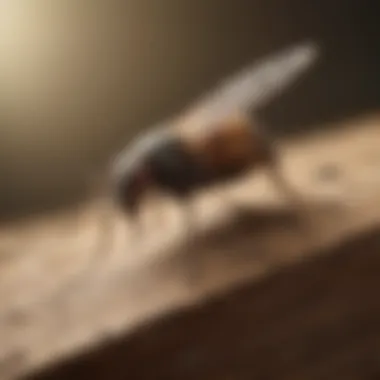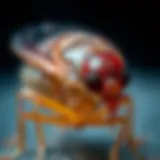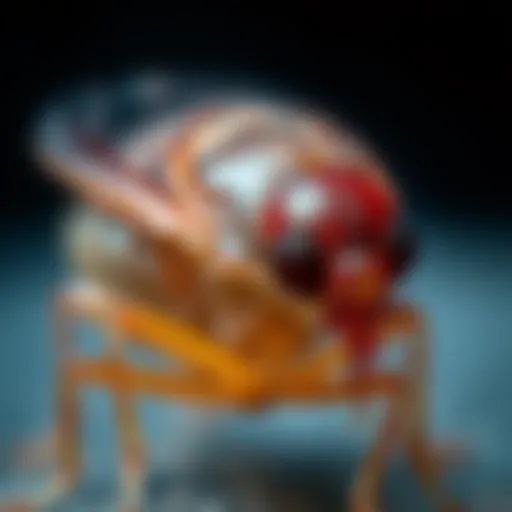Ehrlich Termite Control: Effective Strategies Explained


Intro
Termites can be a significant threat to homes, causing extensive damage that may go unnoticed until it is too late. Understanding how to identify these pests and the signs of their presence is crucial for effective control. This guide aims to empower homeowners with the knowledge necessary to tackle termite infestations through preventive measures, treatment options, and practical tips for long-term management.
Pest Identification
Termite identification is an essential first step in managing these pests. Their biology and behavior can often be overlooked, leading to severe property damage. Here, we discuss common household pests and their signs of infestation.
Common Household Pests
While there are many pests that could disrupt your home, termites pose a unique challenge. The two most common types are subterranean and drywood termites. Subterranean termites are prevalent in many regions and build mud tubes as shelter and pathways to food sources. Drywood termites, on the other hand, live within the wood they consume. Their presence is often signified by fecal pellets visible on surfaces near infested wood.
Signs of Infestation
Identifying signs of a termite infestation can save homeowners from potential destruction. Some common indicators include:
- Mud tubes: These tubular structures allow termites to travel between their nest and food sources, often found in foundations or on walls.
- Wood damage: Hollowed or crumbling wood may suggest termite feeding.
- Frass: Tiny droppings resembling sawdust found near infested wood can indicate drywood termite presence.
Important: Pests like ants may be confused with termites. Observing the distinct features and habits of the insects is key to accurate identification.
Prevention Methods
Preventing termite infestations is often more effective than treating them. Homeowners can take several steps to reduce risk.
Environmental Modifications
Creating barriers in the home's environment can limit termite access. Consider these modifications:
- Soil treatment: Use appropriate products that create a protective barrier in the soil around the home.
- Eliminate wood-to-soil contact: Ensure that wooden structures do not sit directly on soil or mulch.
Home Maintenance Tips
Regular home maintenance plays a critical role in termite prevention. Here are some actionable tips:
- Inspect gutters and downspouts to prevent water accumulation around the foundation.
- Seal cracks and openings in the foundation to block entry points.
- Ensure proper ventilation in basements and attics to reduce moisture.
DIY Pest Control Solutions
For homeowners looking to take matters into their own hands, DIY pest control solutions can be a viable option. However, seriousness and caution are required when dealing with termites.
Natural Remedies
Some homeowners prefer eco-friendly options. Natural repellents include:
- Neem oil: Known for disrupting termite feeding and breeding.
- Boric acid: Deters termites when applied to infested areas.
DIY Traps and Barriers
Constructing simple traps can also aid in controlling termite populations:
- Use cardboard traps to attract termites; once infested, burn them.
- Set up physical barriers like sand or steel mesh around the home’s foundation.
Finale
Understanding Termites
Understanding termites is crucial for any homeowner or household manager. These pests can cause significant structural damage if left unchecked. By knowing more about termites, individuals can take preventive measures and act swiftly when they spot signs of an infestation. This section covers the types of termites and their life cycles, helping readers grasp the importance of termite control.
Types of Termites
Subterranean Termites
Subterranean termites are often regarded as the most destructive type among different kinds of termites. They live underground, forming colonies that can number in the millions. These termites can enter homes through damaged wood or directly from the soil. Their key characteristic is their dependency on moisture, as they cannot survive in dry conditions. This species plays a major role in the ecosystem by breaking down wood, but their activity becomes problematic when it leads to structural damage in homes.
Advantages of subterranean termites include their integral part in recycling dead plant matter in nature. However, their ability to damage wooden structures makes them a topic of serious concern in pest control.
Drywood Termites
Drywood termites are another common species but differ significantly from subterranean one. They can live in wood without the need for contact with soil, making them harder to detect. These termites usually establish colonies within a piece of timber, such as furniture or framing, which is why their identification is often delayed until damage is visible. Their ability to thrive in dry wood poses unique challenges for homeowners.
A key characteristic of drywood termites is their production of frass, which is a mixture of wood particles and droppings. This can serve as a sign of their presence. This independence from moisture can be both advantageous and problematic. While it makes them easier to infest certain wood products, it also suggests that infestations might develop unnoticed for a long time.
Dampwood Termites


Dampwood termites prefer moist environments and are typically found in areas with high humidity. They are larger than other types of termites and will usually inhabit decaying wood, which makes their presence more obvious. A notable characteristic of dampwood termites is that they require wood with a moisture content higher than 20%.
These termites contribute to the decomposition process in forests but can damage wooden structures if the wood is not well-maintained. A unique feature of dampwood termites is their dependence on moisture, which can be exploited in control methods by reducing moisture levels around a home.
Termite Life Cycle
Understanding the life cycle of termites can provide insight into their behaviors and habits. It consists of several stages, each playing a role in how colonies grow and cause damage.
Egg Stage
The egg stage begins the life cycle. Female termites can lay hundreds of eggs in a day, leading to rapid colony growth. The eggs are tiny and white, making them hard to spot. This stage is vital since it signifies the beginning of a new generation of termites. Homeowners should be aware that the more eggs are laid, the greater the potential for damage.
The advantage of the egg stage is the potential for quick population expansion, but this also means that infestations can escalate rapidly if not addressed.
Nymph Stage
Once the eggs hatch, they enter the nymph stage. This stage allows the termites to grow and develop into workers, soldiers, or reproductive adults. Nymphs resemble adults but are smaller. They undergo molting several times before reaching maturity. Understanding this stage is important as nymphs contribute to the colony through different roles.
A critical aspect of the nymph stage is that it creates a workforce for the colony. However, since they are also potential future breeders, it raises concerns about long-term infestations.
Adult Stage
The adult stage is the final phase in the life cycle of termites. This is when they assume their reproductive roles within the colony, with queens capable of producing thousands of eggs. The presence of adults is crucial for colony sustainability. However, their destructive capabilities can lead to substantial damage.
The adult stage is marked by specialization, with workers gathering food and soldiers protecting the colony. While they play an important role, their capacity for causing damage is significant. Homeowners must understand the full lifecycle to implement effective control strategies.
"Proper knowledge about termites can empower homeowners to take action before a minor infestation turns into a major threat."
By grasping how these pests develop and behave, one can be better prepared for prevention and intervention strategies to protect property.
Signs of Termite Infestation
Understanding the signs of a termite infestation is essential in taking timely action. By recognizing these indicators, homeowners can mitigate damage and protect their properties. Termites often operate in silence, which makes early detection critical. Ignoring the signs can lead to extensive damage, which is often much more costly than preventive measures. Effective inspection and observation skills can make a significant difference in controlling these pests.
Identifying Damage
Wood Damage
Wood damage is often the first visible sign of a termite infestation. Termites consume wood, and their presence can cause significant structural weakness over time. Key characteristics to note include hollowed wood and visible cracks. Understanding wood damage helps in early detection and can save on repair costs. If wood appears swollen or discolored, it is a cause for concern. When damage is left unchecked, it can lead to costly repairs. It is advisable to routinely inspect wooden structures, particularly in areas near soil or moisture.
Frass (Termite Droppings)
Frass is another critical sign of termites. It is their droppings, resembling tiny pellets, often seen around infested areas. This characteristic is distinct and serves as a clear indicator of an active infestation. The presence of frass suggests nearby termite activity and can guide effective inspection strategies. Frass may also accumulate around wood fixtures, providing clues. Identifying frass early helps prevent further infestations. Homeowners should be observant, especially in damp areas or near wooden structures.
Swarmers and Wings
Swarmers are winged termites that emerge during mating season, often visible in spring. They signify an established colony nearby. This is a pivotal indication that homeowners should not overlook. Once they shed their wings, they may be found scattered near windows or light sources. The presence of swarmers can indicate a potential infestation that requires immediate attention. Identifying swarmers aids in understanding the life cycle of termites and suggests appropriate action.
Common Infestation Sites
Basements and Crawl Spaces
Basements and crawl spaces are prime targets for termites due to their proximity to damp earth. These areas often harbor moisture, making them ideal habitats. The concealed nature of these spaces can result in undetected infestations for long periods. Homeowners should routinely inspect these sites, focusing on foundations, wooden support structures, and insulation. Identifying any signs of termite activity in these areas can prevent extensive damage.
Attics and Roofs
Termites can also infiltrate attics and roofs. They may access these areas through small openings or vents. Homeowners often overlook attics, but this can lead to severe damage over time. Evidence of infestation can include softened wood and sagging ceilings. Inspecting these areas regularly ensures that infestations are detected early. This proactive approach helps maintain structural integrity and prolongs the life of roofing materials.
Foundation and Landscaping
The foundation and landscaping around a home are critical zones to monitor. Termites thrive in soil and can enter structures through cracks in the foundation. Landscaping features, such as wood mulch or stacked firewood, can attract termites. Keep these areas well-maintained and consider implementing physical barriers. Ensuring that the foundation is clear of debris helps minimize the risk of infestation. Understanding the relationship between landscaping and termites is vital for long-term prevention.
Ehrlich Termite Control Methods
Ehrlich's approach to termite control is multifaceted, addressing the complexities of pest management effectively. This section elaborates on essential methods including inspection processes, prevention strategies, and treatment options. By utilizing these methods, homeowners can mitigate the risks associated with termite infestations and ensure their properties remain protected. A thorough understanding of these strategies provides a solid foundation for both immediate and long-term pest management.
Inspection Process
Initial Assessment
The initial assessment serves as the first step to identifying termite presence in a home. It typically involves a visual examination of accessible areas, focusing on signs of activity such as damage or droppings. This process is crucial because it sets the direction for the entire control plan. A key characteristic of the initial assessment is its non-invasive nature, which reduces disruption to the household. Moreover, it is highly beneficial as it can often be completed efficiently by trained professionals. The unique feature here is that it allows for rapid identification of potential problem areas without advanced tools.
In-depth Examination
Following the initial assessment, an in-depth examination becomes necessary. This involves accessing less obvious areas, such as hidden wood structures or crawl spaces. The contribution of this phase is significant as it ensures that no potential termite activity goes unnoticed. A major strength of the in-depth examination lies in its comprehensive approach, allowing for precise identification of infestations. The distinctive feature is the use of specialized tools and technology, ensuring accurate findings. However, this method can be more time-consuming and may require additional costs, yet the detailed information obtained makes it worthwhile.


Reporting Findings
Concluding the inspection process is the reporting of findings. This step provides a detailed account of the examination results and any identified risks. The contribution of reporting findings is essential in creating an informed strategy for treatment and prevention. A key aspect of this report is its clarity, as it outlines specific issues and recommended actions. It is a popular choice for its role in guiding homeowners on next steps. The unique feature of a comprehensive report is that it often includes visuals and descriptions, which can be quite helpful. One disadvantage might be that the report can come with technical jargon, making it less accessible for some homeowners.
Prevention Strategies
Moisture Control
Moisture control is a fundamental strategy in preventing termite infestations. Termites are attracted to damp environments, making it crucial to monitor and reduce moisture in and around the home. The importance of this tactic lies in its dual role of protecting against termites and improving overall home health. A key feature of moisture control involves routine checks for leaks and proper drainage systems. It is a beneficial choice because it often requires minimal cost and effort. However, one disadvantage is that homeowners may not always know where to look or may overlook small leaks.
Proper Ventilation
Proper ventilation systems minimize humidity buildup in various parts of the home, particularly in attics and crawl spaces. This strategy greatly contributes to the overall prevention of termite activity. A significant characteristic is that it promotes air circulation, which helps to eliminate moisture. This is a popular choice due to its long-term benefits and relative ease of implementation. Its uniqueness lies in its ability to enhance indoor air quality while also deterring pests. A downside may be that some homes may require more extensive renovations to achieve ideal ventilation, which could incur higher costs.
Physical Barriers
Implementing physical barriers is another effective method for termite prevention. These barriers typically involve treated wood, steel mesh, or sand to obstruct termite access to the home. Their utility is prominent, contributing significantly to reducing the likelihood of infestations. A noteworthy characteristic is their permanence; once installed, they provide long-lasting protection. This method is beneficial as it doesn’t rely on chemical treatments, making it an eco-friendly choice. However, the installation process may require professional assistance, which can add to the overall expense.
Treatment Options
Baiting Systems
Baiting systems are an advanced method for managing termite populations. They involve strategically placing bait stations around the property, containing substances that attract termites and ultimately lead to their elimination. The contribution of this method is notable as it targets termites discreetly and minimizes pesticide usage near the home. A distinctive feature of baiting systems is their ability to provide continuous monitoring. This method is beneficial for those who prefer a less invasive approach. One drawback is that results may take time, making it less appealing for immediate situations.
Liquid Treatments
Liquid treatments involve the application of chemical barriers in the soil around a home. This method serves as a proactive approach, preventing termites from entering the structure. The significance of liquid treatments cannot be overstated, especially for established infestations. Their key characteristic is the fast-acting nature of chemicals used, which can yield quick results. This option is popular for its broad application area. However, environmental concerns over chemicals may deter some homeowners from considering this method.
Fumigation
Fumigation is a comprehensive treatment designed to eradicate termites from an entire structure. This process involves sealing the home and introducing a gas that penetrates to eliminate pests. The contribution of fumigation is paramount when dealing with severe infestations, as it ensures thorough treatment. A significant characteristic is its ability to reach all areas of the home, including hidden spaces. This method is highly effective and can provide long-lasting results. On the downside, it necessitates the temporary relocation of residents and pets, which can be inconvenient for many homeowners.
DIY Termite Management
Managing termites at home can seem overwhelming. However, the topic of DIY termite management is crucial in the context of this guide. Homeowners can take actionable steps to reduce termite risk and manage minor infestations before they escalate. Engaging in DIY termite management not only helps save money but also empowers individuals by giving them control over their living environment.
Homeowner Tips
Regular Inspections
Regular inspections are a vital aspect of effective termite management. Conducting these assessments regularly allows homeowners to identify potential problems early. The key characteristic of regular inspections is their proactive nature. This method is beneficial because it fosters a consistent monitoring routine.
The unique feature of regular inspections lies in their ability to uncover hidden issues. For instance, termites often hide in walls or beneath floors. Detecting them early can prevent extensive damage. On the downside, some homeowners may not have enough knowledge to perform thorough inspections. Therefore, seeking guidance or advice on what to look for might be necessary.
Seal Entry Points
Sealing entry points is another important practice for DIY termite management. Termites often gain access to a structure through small cracks and crevices. The key characteristic of sealing entry points is that it blocks potential access points. For homeowners, this is beneficial as it prevents termites from entering the home.
The unique feature of sealing entry points is its simplicity. Homeowners can easily apply caulk or fill gaps with suitable materials. However, the disadvantage lies in the fact that it requires diligence. Individuals must remain vigilant and continually check for new entry points that may develop over time.
Remove Wood Debris
Removing wood debris around the home plays a significant role in reducing termite attraction. The specific aspect of eliminating wood debris is essential because it addresses one of the primary food sources for termites. The key characteristic is that it creates less favorable conditions for these pests. Homeowners benefit by decreasing the risk of infestation.
The unique feature of this strategy is its straightforward application. Stacks of wood or dead vegetation can be removed or relocated away from the home. However, one disadvantage could be the presence of hidden wood that may not be easily visible. Therefore, it is important to inspect the yard thoroughly to eliminate other potential food sources.
Natural Remedies
Natural remedies offer additional options for those looking to manage termite populations effectively. These methods can serve as alternatives or complements to conventional treatments.
Borates
Borates are a popular choice in DIY termite management due to their effectiveness. The specific aspect of borates is that they work as a slow-acting poison. The key characteristic is that they can be applied to wood surfaces. Homeowners benefit from this method because it prevents future infestations as well.
The unique feature of using borates is that it is a relatively low-toxicity solution. This makes it safer for residential use compared to some chemical treatments. However, one disadvantage is that borates may not provide immediate results in severe infestations. Patience is necessary while utilizing this method.
Essential Oils
Essential oils also offer a natural approach to termite management. A specific aspect of utilizing essential oils is their repellant qualities. The key characteristic is that certain oils, like clove and orange oil, are known to deter termites. Homeowners may find this method appealing due to its pleasant scent and non-toxic nature.
The unique feature of essential oils is that they can be easily applied. Spraying diluted oil in infested areas is often sufficient. Nevertheless, the disadvantage of this option is that it may not eliminate existing colonies effectively. Instead, it serves as more of a preventive measure.
Beneficial Nematodes
Beneficial nematodes present another natural solution to termite management. These microscopic worms attack and kill termites. The specific aspect is their capacity to reduce termite populations organically. The key characteristic of beneficial nematodes is that they are safe for other beneficial organisms. Homeowners may appreciate this method due to its eco-friendly approach.


The unique feature of beneficial nematodes is that they require some understanding of their application. Homeowners must ensure they maintain optimal conditions for these organisms. One disadvantage is their dependency on environmental factors such as moisture levels. Continuous monitoring of these conditions is essential for their success.
The Role of Professionals
When facing a termite infestation, the role of professionals becomes essential. These experts offer knowledge and tools that homeowners may lack. They understand termite behavior and biology, which assists in developing targeted strategies for control. Our focus is on finding a qualified pest control company to ensure effective results in managing these pests.
Choosing a Pest Control Company
Selecting the right pest control company is critical to successful termite management. Many factors should be considered, each contributing to the overall effectiveness of the treatment.
Licensing and Certifications
Licensing and certifications signify a company's legitimacy and adherence to regulatory standards. These credentials ensure that the pest control experts have received training and are knowledgeable about the latest practices in termite management. A licensed professional can apply treatments safely and effectively.
The key characteristic of proper licensing is compliance with local and state regulations. This makes it a beneficial choice for any homeowner looking to hire a pest control service. Unique features of certifications often include ongoing education requirements. This requirement keeps professionals up-to-date, enhancing their service quality. In the context of termite control, such measures also ensure that environmentally safe methods are prioritized, reducing potential harm to the surrounding ecosystem.
Experience and Expertise
Experience and expertise in the field of pest control play a vital role in determining effective strategies. Companies with years of service generally possess a better understanding of local termite species and their habits. This knowledge allows them to devise treatments that address specific areas of concern in a residential setting.
Highlighting the key characteristic of experience is its relationship with a proven track record. This makes it a popular choice among homeowners who value results. Unique features of experienced professionals often include access to advanced technology and treatment options. The advantages here are significant: experienced pest control providers can tailor approaches based on the homeowner's specific needs, potentially reducing costs in the long run.
Customer Reviews and Testimonials
Customer reviews and testimonials provide insights into the effectiveness of a pest control service. These accounts allow potential clients to gauge the reputation and quality of service offered by a company. Positive feedback often indicates successful termite management, building confidence among homeowners.
The key characteristic of transparent customer feedback is its firsthand perspective. This makes it a powerful tool when choosing a provider. Unique features include both detailed written accounts and star ratings. The advantage of trusting customer reviews lies in their authenticity. Real experiences can reveal a company's strengths or weaknesses, guiding homeowners toward informed decisions.
What to Expect from Professional Services
Upon hiring a professional service, homeowners should know what to expect during the entire process. Understanding the journey enhances predictability and satisfaction with the service.
Initial Consultation
The initial consultation is a foundational element of professional pest control services. This meeting allows providers to assess the extent of the infestation and discuss potential strategies with homeowners. This initial step clarifies expectations and treatments available to the homeowner.
The key characteristic of an initial consultation is its comprehensive nature. This ensures a tailored approach to treatment, emphasizing its importance in the overall process. A unique feature of this consultation typically includes a thorough property inspection, allowing professionals to gather valuable data. The benefits of this detailed assessment directly impact the quality of the treatment plan that follows.
Customized Treatment Plans
A customized treatment plan is crucial for addressing specific needs of a property. Each home is unique, and termites can behave differently depending on various factors. Customized plans consider these variables to ensure efficient intervention.
The primary characteristic of a customized treatment plan is its adaptability. This aspect makes it a beneficial strategy in managing infestations effectively. Unique features of such plans can include specialized treatment methods and scheduled follow-ups tailored to the homeowner’s preferences. The clear advantage here is that issues are addressed promptly, reducing the risk of further damage to the property.
Follow-up Services
Follow-up services are essential for ensuring ongoing pest management. After treatment, these services monitor the situation and provide necessary adjustments to the initial plan. Continuous attention keeps pest issues at bay and reinforces the homeowner's investment.
The significant aspect of follow-up services is their role in long-term pest management. As such, they guarantee that any signs of a resurgence are dealt with quickly. Unique features can include regular inspections or even maintenance treatments. The overall benefit is achieved peace of mind for homeowners, knowing that professionals are committed to protecting their property against termites.
Long-Term Pest Management Strategies
Long-term pest management strategies are crucial for the effective control of termites. They help minimize damage, protect home structures, and reduce the costs associated with infestations. By understanding these strategies, homeowners can create an environment that deters termites over the long haul. A proactive approach is more effective than reactive measures.
Monitoring and Maintenance
Annual Inspections
Annual inspections play a vital role in termite management. These routine assessments help identify any signs of infestation early on. Homeowners can catch termite issues before they escalate into significant damage. The essential characteristic of these inspections is their preventive nature. They are a popular choice for maintaining a pest-free home. Unique features of annual inspections include comprehensiveness and the ability to adapt to changing conditions in and around the home. Their advantage is in early detection, but the disadvantage lies in the reliance on sticking to a schedule. If not performed regularly, signs of termite activity could go unnoticed.
Cultural Controls
Cultural controls contribute significantly to termite management. This approach involves modifying the environment to make it less conducive to termite infestations. A key characteristic is the focus on altering practices that inadvertently attract termites. These methods are beneficial because they can be implemented at minimal cost. A unique feature of cultural controls is their sustainable nature. They tend to emphasize long-term solutions, such as changing landscaping practices or improving drainage. However, one disadvantage could be the need for ongoing education to ensure effectiveness.
Continuous Education
Continuous education is essential for effective pest management. It reinforces the knowledge needed for homeowners to recognize and respond to potential termite threats. The key characteristic of continuous education is its dynamic nature. It remains relevant as termite behavior and control technologies evolve over time. This is beneficial because it empowers homeowners, allowing them to take charge of their property. One unique feature is the availability of resources through workshops or online courses. However, the challenge may arise from busy schedules, making it harder for homeowners to find time for education.
Integrating Sustainability
Eco-Friendly Pest Control Products
Eco-friendly pest control products are becoming increasingly popular. Their contribution lies in providing pest management solutions that minimize environmental impact. A key characteristic is their formulation from natural ingredients, making them safer for both humans and pets. This choice is beneficial because it aligns with the growing trend toward sustainable living. A unique feature is that many of these products are highly effective without harsh chemicals. The downside could be that they sometimes require repeated applications for lasting effects.
Promoting Biodiversity
Promoting biodiversity contributes to a balanced ecosystem that can naturally deter pests like termites. The key characteristic is fostering a variety of species that create natural checks on pest populations. This practice is beneficial for enhancing environmental health. A unique feature is the potential for educational programs that inform homeowners on how to create biodiversity-friendly gardens. However, one disadvantage may be that it requires patience as ecosystems can take time to establish.
Community Awareness Initiatives
Community awareness initiatives help educate neighborhoods about termite issues and prevention strategies. Their contribution is significant for creating collective action against infestations. A key characteristic of these initiatives is inclusiveness, offering workshops or seminars for all residents. This approach is beneficial because shared knowledge strengthens community resilience against pest threats. A unique feature is the potential for establishing local support networks. The downside, however, could be variance in engagement levels among community members.















